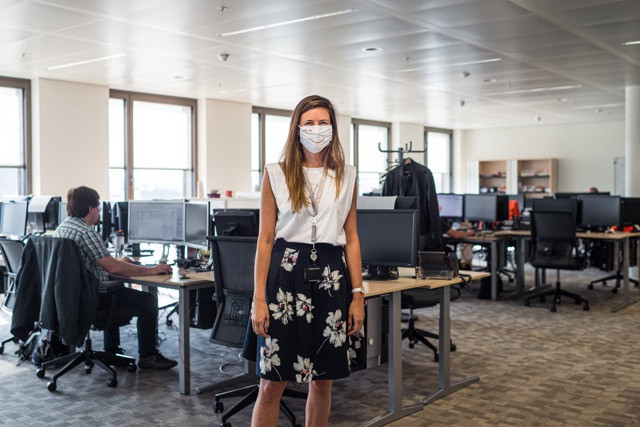Florence Auquier, product owner for daily banking at ING, was used to occasionally working from her home in Strassen before lockdown. She used to work remotely around once a month, for instance when she had a delivery coming or other household appointments. “But the setup is not the same. We cannot use all the tools that we have in the office here,” she said in an interview in early September.
Starting March, 85% of the 1,000 or so employees at the ING offices in Luxembourg-Gare were able to work remotely. “The process went pretty smoothly. There were some minor hiccups in the beginning, obviously, because not all the infrastructure was in place,” Auquier said. Her home office was a simple one: a small Ikea desk in her room and a new monitor she purchased shortly before lockdown, a smart investment as it meant she didn’t have to “strain my eyes with the tiny screen on the laptop.”
Colleagues
Auquier missed the human contact and so was happy to volunteer to be among the first wave of staff to return to the office on 15 June. Teams were organised to come into the office on alternate weeks with the aim to return to 20% capacity as soon as possible. Even now, staff are split into A and B groups, working two weeks in the office and two weeks at home.
In reality, Auquier said that in September there was only ever between 35% and 40% of staff in the office at any given time because of holidays, sick leave and individual health conditions that may predispose individuals to covid-19. Since June, Auquier has adapted to new hygiene regulations at her workplace, but she also changed her daily commute from her home in Strassen. “I started using my own car instead of the bus, because it’s safer and easier--the buses were quite full during rush hour.”
Workplace
ING, which received certification from the ASTF for its back to the office standards, provided returning staff with a booklet containing hygiene guidance, and floors were marked with pathways and circles indicating how far apart employees should stand at entrances or while waiting for a lift, for example.
Its facility management department and human resources team closely monitor the situation and always put safety first. “We’d rather go a bit slower now than try to go too fast and then have to go back to square one and send everybody home and then figure the whole thing out again.”
Workflow
Employees mostly used Skype for Business and Webex, and if staff didn’t have a webcam, the teams switched to FaceTime. “It’s nice to hear a voice, but it’s also nice to see the expression on faces,” Auquier said.
They’d have 15-minute daily catch-up meetings which were frequently interrupted by family members. “One time a colleague’s husband walked behind her in undies,” she recalled with a smile.
Auquier remained focussed by dressing and getting ready for work as if she was going into the office, even if she wouldn’t see anyone all day, “I think you need to do this for your own sanity”.
ING provided advice for those working remotely and allowed staff a certain degree of flexibility on the timing of their workday, depending on their daily routine--so those who were early risers could start at 7:30 a.m., for example, and finish at 4:30 or 5 p.m. But that meant meetings also had to be timed accordingly.
Update: Following an appeal on 23 October from the CSSF to all entities under its supervision, ING says it is making use of remote working once again wherever possible. “At ING we believe we are in this together and we strive to help prevent the spread of the virus,” said the bank’s head of corporate services, Bárbara Daroca.
Read the entire “Happy to be back in the office?” series online or in the Delano October/November 2020 magazine
